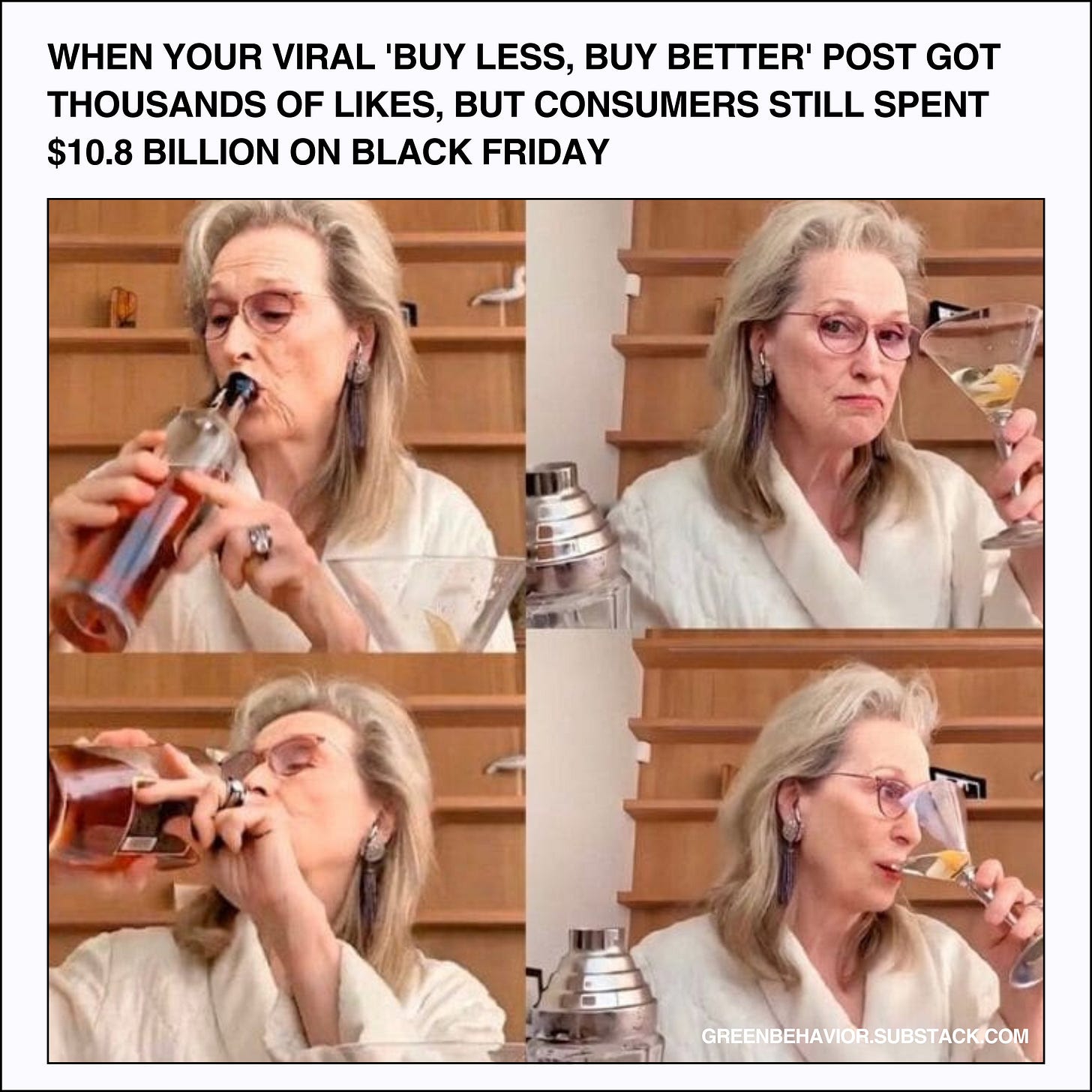Black Friday’s $10.8 Billion Reality Check: Guilt-Driven Messaging Doesn't Change Consumer Behavior—Here's What Does
Read this before your next marketing meeting.


In the days leading up to Black Friday, my timeline was filled with posts urging people to shop less, buy better, or avoid shopping altogether.
Commentary about the new Netflix documentary Buy Now! The Shopping Conspiracy, images of overflowing landfills, alarming statistics about global waste, and posts with messages like, “Don’t buy shit you don’t need,” got thousands of likes, comments, and shares across social media.
On the surface, it seemed like the message might have resonated: fewer Americans shopped during Thanksgiving weekend this year. According to the National Retail Federation and Prosper Insights & Analytics, 197 million people shopped from Thanksgiving to Cyber Monday—a 1.7% drop from last year’s record of 200.4 million.
But despite fewer shoppers, spending reached new heights. U.S. shoppers spent a record-breaking $10.8 billion online on Black Friday alone—a 10.2% increase from last year’s $9.8 billion.
TikTok also saw explosive growth during the shopping weekend. The app tripled its U.S. shopping sales to over $100 million on Black Friday.
On LinkedIn, Shopify president Harley Finkelstein proudly celebrated that Shopify merchants hit a record-breaking $5 billion in sales, with a peak of $4.6 million per minute, declaring, “it’s clear that Black Friday belongs to entrepreneurs.”
Meanwhile, behind-the-scenes, Shopify is strategically shifting its focus to signing bigger clients like Reebok, Overstock, and Barnes & Noble to diversify its revenue stream and ensure long-term stability. 👀
By the end of the weekend, after Shopify merchants’ total sales during Black Friday Cyber Monday (BFCM) weekend reached $11.5 billion, he shifted his tone in a follow-up post, stating, “One thing that I know is true: Black Friday Cyber Monday weekend belongs to Shopify merchants.”
If you’re curious, the top product categories sold on Shopify were clothing tops, cosmetics, fitness and nutrition products, pants, and activewear. Customers checked out with an average cart value of $108.56 USD.
Paypal also had its biggest day of the year on Cyber Monday, processing $7 billion in payments—$81,000 per second. Unsurprisingly, retail was the most shopped category. 🤷🏾♀️
Adobe Analytics added to the record-breaking headlines, reporting that Cyber Monday alone accounted for $13.3 billion in spending, which helped drive a staggering $35 billion in online sales during the entire BFCM period.
Looking ahead, Adobe projects consumers will spend a record-breaking $241 billion online during the 2024 holiday season. As of December 2, online spending has already hit $131.5 billion since November 1.
In the aftermath of these record-breaking numbers, instead of images of landfills and waste statistics, my timeline is filled with news articles about record-breaking Black Friday spending and people asking: Why don’t consumers act according to their values?!
Plot twist: they do —we’re just assuming their values revolve solely around sustainability.
As sustainability advocates, we often assume that because consumers care about sustainability, their values are exclusively centered around it.
The logic seems simple: consumers say they care about sustainability. So we create campaigns centered around next-gen materials, ethical practices, and reduced waste. We tell stories about saving the planet. And then, when the sales don’t come, we’re left wondering, What went wrong? I’m tapping into *their values* why isn’t this working?
The truth: consumer values are broader, more nuanced, and far more complex than the sustainable fashion community cares to acknowledge.
Yes, consumers care about sustainability—but they care about other things more. Identity, belonging, social status, group affiliation, emotional fulfillment, and self-expression are the real drivers of most purchasing decisions. Price and convenience, especially during events like BFCM only amplify those motivations.
Another possible explanation for this surge in spending could be President-elect Donald Trump’s proposed tariffs on imports from Canada, Mexico, and China, which may lead to higher prices in the near future. Consumers might be rushing to take advantage of current prices, fearing that essentials and big-ticket items could become more expensive down the line.
These nuanced motivations, coupled with economic concerns like the potential impact of tariffs, create a perfect storm that drives consumers to shop more during events like Black Friday. For sustainable brands, this makes Black Friday an especially challenging moment to navigate.
It represents everything they’re trying to move away from: hyper-consumption, impulse buying, and the obsession with discounts over thoughtful purchasing. It’s the polar opposite of slow fashion and mindful consumption.
Every year, I get asked: Should sustainable brands opt out of Black Friday altogether?
To this I say:
And yet, $10.8 billion was spent. For every sustainable fashion brand that chose to close their doors or sit out in protest, that’s a slice of the massive spending pie they deliberately walked away from.
Here’s the thing: Black Friday isn’t just about shopping—it’s a cultural event. It’s about excitement, tradition, and, for many, the thrill of scoring deals. Like it or not, it’s deeply embedded in consumer behavior.
By opting out entirely, sustainable brands leave the playing field wide open for unsustainable brands to dominate.
Consumers who will shop anyway—because they’ve budgeted for it, because they’re caught up in the excitement, or simply because they want to participate—are left with fewer (or no) sustainable options.
Closing on Black Friday might send a strong message to your loyal, values-aligned audience, but it doesn’t do much to disrupt the buying habits of mainstream consumers—the ones who most need sustainable alternatives.
Sitting out doesn’t solve the problem—it just lets someone else control the narrative.
By showing up and engaging with consumers when their attention is laser-focused on shopping, sustainable brands have a chance to shift the narrative from within.
To be clear: participating doesn’t mean compromising values. It doesn’t mean mimicking fast fashion tactics. Black Friday can be an opportunity—a moment to reshape what it means to shop responsibly. (I love the way these brands approached Black Friday this year!)
The question isn’t should consumers opt out of Black Friday, the question is can sustainable brands really afford not to participate?
If we want sustainability to scale, we have to adapt to how people naturally consume—especially during events like Black Friday. That means understanding and speaking to the full range of consumer values.
It’s not that people don’t care about sustainability—it’s that guilt-based, morality-heavy messaging doesn’t inspire action on a large scale.
Guilt can grab attention in the moment, but its impact is fleeting. While it might spark awareness, it rarely drives lasting behavior change because it’s overshadowed by stronger motivators like belonging, identity, and social status—factors that feel immediate, personal, and far more rewarding.
Photos of landfills and statistics about global waste, while powerful, often feel distant and abstract. They might momentarily upset someone, but unless the issue feels directly connected to their own lives or they see how they can make a difference, it’s unlikely to inspire action.
Someone might see a post about waste and think, 'That’s awful,' but moments later, they’re scrolling past and buying the latest product their favorite influencer recommends. The issue hasn’t been internalized, and the call to action is lost.
Overusing guilt in sustainability messaging can also backfire by overwhelming people with the scale of the problem, making solutions feel unattainable and triggering avoidance behaviors. Over time, this approach leads to compassion fatigue—where constant exposure to negative messages makes people disengage because they feel powerless to help.
To create meaningful change, sustainability messaging needs to move away from guilt and focus on empowerment. Highlight achievable solutions and tangible benefits that resonate with people’s personal values (not just sustainability values) and aspirations. When sustainability feels exciting, accessible, and tied to who people are and how they want to be seen, it becomes part of their identity, not just a fleeting concern.
Embedding sustainability into the culture of consumption requires us to speak to how people naturally think, feel, and shop. Here’s how:
Stop preaching to the sustainability choir. Sustainability messaging often targets an audience already aligned with sustainable values—those who are already informed, engaged, and committed to making conscious choices. This creates an echo chamber, limiting the reach and impact of the message. Instead we should meet people "where they are." This means understanding and addressing the realities of those who aren't already on board—their current habits, emotional motivations, etc., Make sustainability relatable and achievable for everyone, not just the already-converted.
Understand consumer motivations beyond sustainability. Consumption is deeply tied to identity—what people buy reflects who they are (or aspire to be) and how they want to be perceived. While sustainability is important to many, it rarely stands alone as their primary motivator. In this context, products are more than just things to buy—they are symbols of the consumer's values, personality, and place in society. For sustainable brands to resonate, they need to align their offerings with these underlying desires while incorporating sustainability as part of the broader appeal.
Reframe sustainability. Move away from guilt-driven messaging that focuses on what consumers are doing wrong or need to stop. Instead, shift the conversation to what they can do and how it benefits them. Sustainability should never feel like a compromise or sacrifice—it should feel empowering, exciting, and like something they actually want to be part of.
Create desirable products with perceived value. People buy into brands before they buy products. It’s not just about how sustainable your product is—it’s about how your brand and product make people feel, what they represent, and the story they tell. Unfortunately, many sustainable brands put marketing and brand-building on the back burner. But here’s the reality: this is what ultimately drives sales.
To be clear, I’m not saying we shouldn’t share facts, post pictures of landfills, or talk about overconsumption. Raising awareness is incredibly important as it’s often the first step in changing minds.
But awareness alone doesn’t translate to action—at least not at the scale we need.
Sharing statistics and images without addressing deeper consumer motivations gets applause from those already aligned with the cause but rarely inspires mainstream behavior change.
We often point to the attitude-behavior gap as the biggest hurdle in shifting consumer behavior, but the real issue isn’t apathy—it’s the disconnect between sustainability efforts and consumer psychology.
Most sustainability initiatives fail to align with how people naturally think, feel, and make decisions.
Sustainability shouldn’t feel like a separate movement or moral burden. By embedding it into the culture of consumption, we can create a future where sustainable products aren’t just ethical—they’re desirable, aspirational, and irresistible.
TLDR: To truly drive change, sustainable brands must:
Consumer values doesn’t exclusively = sustainability. Sustainability is one of many priorities for consumers, but identity, belonging, convenience, and social status often carry more weight in their purchasing decisions.
Guilt-based messaging is ineffective: It grabs attention but rarely drives long-term behavior change and can lead to compassion fatigue.
Speak to broader consumer motivations: Align products with identity and aspirations while integrating sustainability as a feature, not the sole focus.
Brand perception matters: Consumers buy into brands before products—sustainable brands need to prioritize building perceived value.
Action requires deeper connection: Awareness alone won’t inspire change—sustainability must align with how people think, feel, and shop.
To truly embed sustainability into consumer culture, we must meet people where they are, not where we want them to be.
BS 🧠🤓






I appreciated this perspective. The sentence that caught my attention most was: "By opting out entirely, sustainable brands leave the playing field wide open for unsustainable brands to dominate." As a co-founder of a sustainable brand, grappling with how to handle BFCM and whether to lean in or away took time. Your sentence was a good reminder that we don't have to be about promoting overconsumption and deal-expiring deadlines to still offer customers a better alternative to what they were already going to to purchase.
Great read!! Thank you